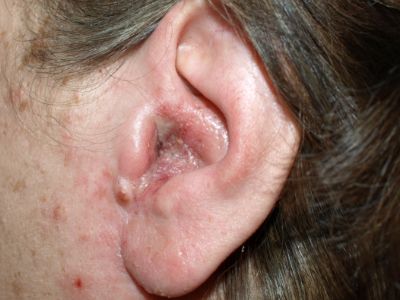Otitis Media

Otitis media is an infection of the middle ear, the air-filled space behind the eardrum in which the tiny vibrating bones are located. This infection is more common in children than in adults.
Ear infections often clear up on their own, so treatment begins with pain management and monitoring. Sometimes, antibiotics are needed to clear the infection.
Otitis Media Symptoms

The following are the most common symptoms of otitis media. However, each child may experience symptoms differently. Symptoms may include:
- Ear pain
- Difficulty sleeping or staying asleep
- Fluid draining from the ear
- Loss of balance
- Tugging or pulling at one or both ears
- Unusual irritability
- Difficulty sleeping or staying asleep
- Fever, especially in infants and younger children
- Hearing difficulties
Causes and Risk Factors of Otitis Media
Infections of the middle ear are usually caused by a malfunction of the Eustachian tube, a canal that connects the middle ear with the throat. By equalizing the pressure between the outer and middle ear, the Eustachian tube helps prevent hearing loss. When this tube does not function properly, it prevents normal drainage of fluids from the middle ear, leading to a buildup of fluid behind the eardrum. When this fluid cannot drain, bacteria and viruses can grow in the ear, causing acute otitis media. The following are some of the reasons that the Eustachian tube may not work properly:
- A cold or allergy can lead to swelling and congestion of the lining of the nose, throat, and Eustachian tube
- A malformation of the Eustachian tube
Several factors may increase your child’s risk of developing an ear infection, although any child can develop it:
- Family history of ear infections
- Being around someone who smokes
- A weak immune system
- Having a cold
Otitis Media Diagnosis
The health care provider of your child will inspect the outer ear and eardrum using an otoscope. This diagnosis is usually done along with a complete medical history and physical examination. A pneumatic otoscope blows a puff of air into the ear to test eardrum movement.
Another test is tympanometry which can be performed in most health care providers’ offices to help determine how the middle ear is functioning. It does not tell if the child is hearing or not, but helps to detect any changes in pressure in the middle ear. This is a difficult test to perform in younger children because the child needs to remain still and not cry, talk, or move. A hearing test may be performed for children who have frequent ear infections.
Otitis Media Treatment
In some cases, ear infections resolve without antibiotic treatment. Depending on your child’s age and the severity of symptoms, you should consider what’s best for him or her.
- Amoxicillin is the first-line drug for Otitis Media. It is a penicillin-type antibiotic that works by stopping the growth of bacteria.
- Ampicilin
- Cefuroxime
- Ciprofloxacin Dexamethasone
In addition, your doctor will advise you on treatments to lessen pain from an ear infection. These may include the following:
Pain medication
- Acetaminophen (Tylenol)
- Ibuprofen (Advil, Motrin IB)
Anesthetic drops
These may be used to relieve pain if the eardrum doesn’t have a hole or tear in it.



